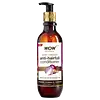What's inside
What's inside
 Key Ingredients
Key Ingredients

 Benefits
Benefits

 Concerns
Concerns

 Ingredients Side-by-side
Ingredients Side-by-side

Water
Skin ConditioningPropylene Glycol
HumectantSodium PCA
Humectant3-O-Ethyl Ascorbic Acid
Skin ConditioningPhenoxyethanol
PreservativeEthylhexylglycerin
Skin ConditioningSodium Benzoate
MaskingAloe Barbadensis Leaf Extract
EmollientNiacinamide
SmoothingAscorbyl Methylsilanol Pectinate
AntioxidantPPG-12-Buteth-16
Skin ConditioningDimethylsilanol Hyaluronate
HumectantHydroxyethylcellulose
Emulsion StabilisingCitric Acid
BufferingParfum
MaskingSodium Gluconate
Skin ConditioningXanthan Gum
EmulsifyingDipotassium Glycyrrhizate
HumectantCitrus Limon Peel Oil
MaskingMentha Citrata Herb Oil
PerfumingWater, Propylene Glycol, Sodium PCA, 3-O-Ethyl Ascorbic Acid, Phenoxyethanol, Ethylhexylglycerin, Sodium Benzoate, Aloe Barbadensis Leaf Extract, Niacinamide, Ascorbyl Methylsilanol Pectinate, PPG-12-Buteth-16, Dimethylsilanol Hyaluronate, Hydroxyethylcellulose, Citric Acid, Parfum, Sodium Gluconate, Xanthan Gum, Dipotassium Glycyrrhizate, Citrus Limon Peel Oil, Mentha Citrata Herb Oil
Water
Skin ConditioningCetyl Alcohol
EmollientIsopropyl Myristate
EmollientPolyquaternium-7
Hydrogenated Polyisobutene
EmollientBehentrimonium Chloride
PreservativeGlycerin
HumectantCetrimonium Chloride
AntimicrobialCocos Nucifera Oil
MaskingPhenoxyethanol
PreservativeBenzoic Acid
MaskingUndecylenoyl Glycine
CleansingCetearyl Alcohol
EmollientGuar Hydroxypropyltrimonium Chloride
Skin ConditioningParfum
MaskingSodium Lauroyl Lactylate
EmulsifyingMethoxycinnamidopropyl Behendimonium Chloride
Butyrospermum Parkii Butter
Skin ConditioningTocopheryl Acetate
AntioxidantSodium Gluconate
Skin ConditioningLysine
Skin ConditioningHistidine
HumectantArginine
MaskingAspartic Acid
MaskingThreonine
Serine
MaskingGlutamic Acid
HumectantProline
Skin ConditioningGlycine
BufferingAlanine
MaskingValine
MaskingIsoleucine
Skin ConditioningLeucine
Skin ConditioningTyrosine
MaskingPhenylalanine
MaskingCysteine
Antioxidant1,2-Hexanediol
Skin ConditioningHydrolyzed Borage Seed Oil Extract
AntioxidantSodium Hydroxide
BufferingHydrolyzed Borage Seed Oil
Skin ConditioningWater, Cetyl Alcohol, Isopropyl Myristate, Polyquaternium-7, Hydrogenated Polyisobutene, Behentrimonium Chloride, Glycerin, Cetrimonium Chloride, Cocos Nucifera Oil, Phenoxyethanol, Benzoic Acid, Undecylenoyl Glycine, Cetearyl Alcohol, Guar Hydroxypropyltrimonium Chloride, Parfum, Sodium Lauroyl Lactylate, Methoxycinnamidopropyl Behendimonium Chloride, Butyrospermum Parkii Butter, Tocopheryl Acetate, Sodium Gluconate, Lysine, Histidine, Arginine, Aspartic Acid, Threonine, Serine, Glutamic Acid, Proline, Glycine, Alanine, Valine, Isoleucine, Leucine, Tyrosine, Phenylalanine, Cysteine, 1,2-Hexanediol, Hydrolyzed Borage Seed Oil Extract, Sodium Hydroxide, Hydrolyzed Borage Seed Oil
Ingredients Explained
These ingredients are found in both products.
Ingredients higher up in an ingredient list are typically present in a larger amount.
Parfum is a catch-all term for an ingredient or more that is used to give a scent to products.
Also called "fragrance", this ingredient can be a blend of hundreds of chemicals or plant oils. This means every product with "fragrance" or "parfum" in the ingredients list is a different mixture.
For instance, Habanolide is a proprietary trade name for a specific aroma chemical. When used as a fragrance ingredient in cosmetics, most aroma chemicals fall under the broad labeling category of “FRAGRANCE” or “PARFUM” according to EU and US regulations.
The term 'parfum' or 'fragrance' is not regulated in many countries. In many cases, it is up to the brand to define this term.
For instance, many brands choose to label themselves as "fragrance-free" because they are not using synthetic fragrances. However, their products may still contain ingredients such as essential oils that are considered a fragrance by INCI standards.
One example is Calendula flower extract. Calendula is an essential oil that still imparts a scent or 'fragrance'.
Depending on the blend, the ingredients in the mixture can cause allergies and sensitivities on the skin. Some ingredients that are known EU allergens include linalool and citronellol.
Parfum can also be used to mask or cover an unpleasant scent.
The bottom line is: not all fragrances/parfum/ingredients are created equally. If you are worried about fragrances, we recommend taking a closer look at an ingredient. And of course, we always recommend speaking with a professional.
Learn more about ParfumPhenoxyethanol is a preservative that has germicide, antimicrobial, and aromatic properties. Studies show that phenoxyethanol can prevent microbial growth. By itself, it has a scent that is similar to that of a rose.
It's often used in formulations along with Caprylyl Glycol to preserve the shelf life of products.
This is the synthetic salt of gluconic acid, a form of PHA and mild exfoliant.
It is mainly used to stabilize oil and butter formulations from going bad. Sodium gluconate is a humectant, pH regulator, and chelating agent.
Chelating agents help neutralize unwanted metals from affecting the formulation.
Sodium gluconate is water-soluble.
Learn more about Sodium GluconateWater. It's the most common cosmetic ingredient of all. You'll usually see it at the top of ingredient lists, meaning that it makes up the largest part of the product.
So why is it so popular? Water most often acts as a solvent - this means that it helps dissolve other ingredients into the formulation.
You'll also recognize water as that liquid we all need to stay alive. If you see this, drink a glass of water. Stay hydrated!
Learn more about Water